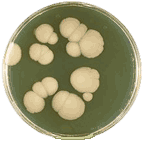Papers in the Biological Sciences
Document Type
Article
Date of this Version
8-2003
Citation
Published in Chemistry & Biology 10 (August 2003), pp 743–750.
DOI 10.1016/S1074-5521(03)00158-3
Abstract
The dimorphic fungus Candida albicans produces extracellular farnesol (3,7, 11-trimethyl-2,6,10-dodecatriene- 1-ol) which acts as a quorum-sensing molecule (QSM) to suppress filamentation. Of four possible geometric isomers of farnesol, only the E,E isomer possesses QSM activity. We tested 40 natural and synthetic analogs of farnesol for their activity in an N-acetylglucosamine-induced differentiation assay for germ tube formation (GTF). Modified structural features include the head group, chain length, presence or absence of the three double bonds, substitution of a backbone carbon by S, O, N, and Se heteroatoms, presence or absence of a 3-methyl branch, and the bulkiness of the hydrophobic tail. Of the 40 compounds, 22 showed QSM activity by their ability to reduce GTF by 50%. However, even the most active of the analogs tested had only 7.3% of the activity of E,E-farnesol. Structure-activity relationships were examined in terms of the likely presence in C. albicans of a farnesol binding receptor protein.
Includes supplemental material.
Included in
Environmental Microbiology and Microbial Ecology Commons, Other Life Sciences Commons, Pathogenic Microbiology Commons



Comments
Copyright © 2003 Elsevier Science Ltd. Used by permission